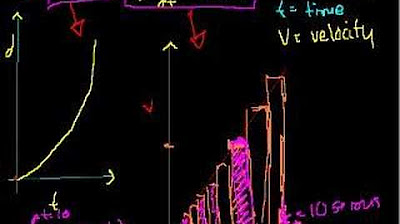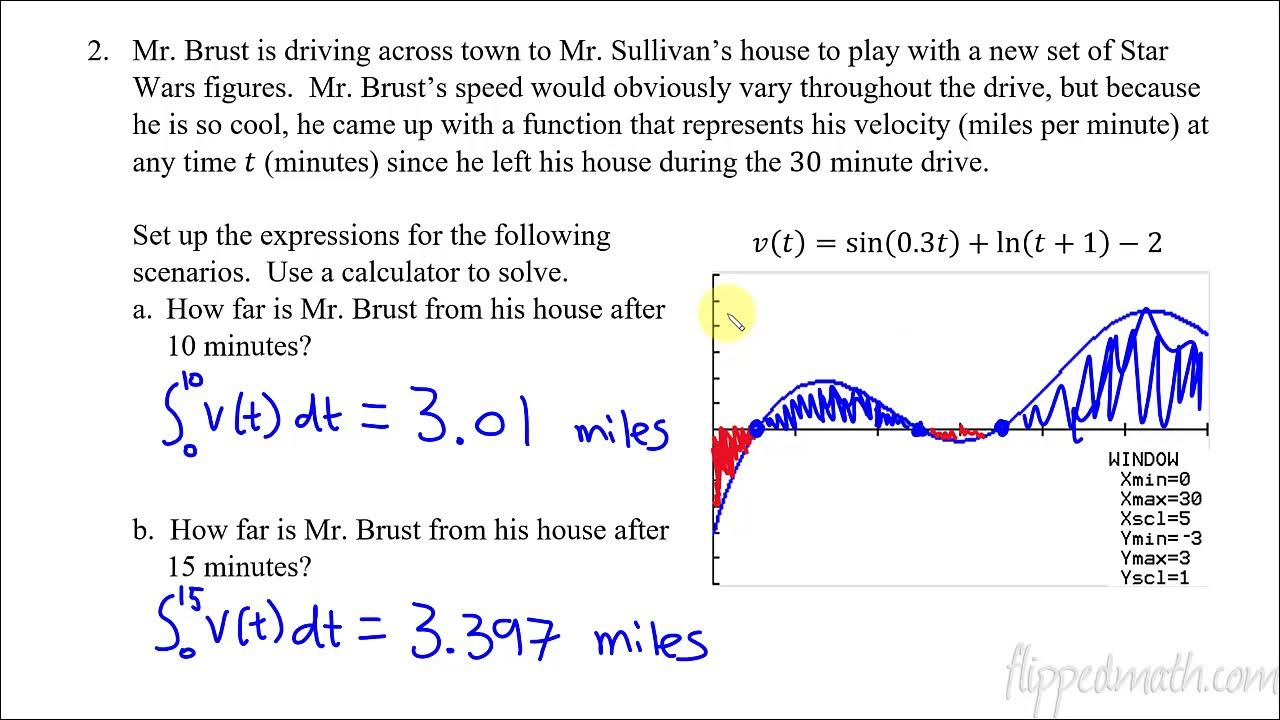Definite Integrals (area under a curve) (part III)
TLDRThe video script discusses the concept of indefinite integrals and their application in calculating the distance traveled by an object, using a cubic function as an example. It explains the relationship between distance, velocity, and acceleration, and how the area under the velocity curve represents the distance traveled within a specific time interval. The script emphasizes the importance of understanding the underlying principles of calculus for practical applications, such as in physics and computer programming.
Takeaways
- 📚 The session aims to explain how to solve indefinite integrals and the rationale behind the process, which is sometimes lacking in textbooks.
- 📈 An example is given where distance (s) is a function of time (t), specifically a cubic function s = 2t^3 + 5 to illustrate the concept of integration.
- 📊 The concept of 'jerk' is introduced as the rate of change of acceleration, though it is not fully explored and a reference to Wikipedia is mentioned for further reading.
- 🚀 The calculation of distance traveled between two time intervals (t=2s and t=5s) is demonstrated by evaluating the function at those points and finding the difference.
- 📌 The derivative of the distance function is calculated to represent velocity (v(t) = 6t^2), emphasizing that velocity is independent of the initial position.
- 📊 A graph of the velocity function is shown to resemble a parabola, highlighting the relationship between the function and its graphical representation.
- 🔄 The connection between physics and calculus is emphasized, suggesting that they should be taught together for a more holistic understanding.
- 📝 The process of approximating the distance traveled between two time intervals using small rectangles (infiniteesimal calculus) is explained.
- 📊 The area under the curve of the velocity function is related to the distance traveled over a time interval, providing an intuitive understanding of integration.
- 🔧 The concept of antiderivatives is introduced as a tool to find the area under a curve, and the process of evaluating the antiderivative at two points to find the difference is demonstrated.
- 🎓 The fundamental theorem of calculus is alluded to, which relates the derivative and antiderivative of a function, although it is not fully detailed in the script.
- 🚀 The application of these concepts to real-world problems and computer programming is mentioned as a way to emphasize the practical importance of understanding calculus.
Q & A
What is the main topic of the video script?
-The main topic of the video script is about solving indefinite integrals and understanding the reason behind the process.
What is the formula for distance given in the script?
-The formula for distance given in the script is s(t) = 2t^3 + 5, which represents a cubic function.
What does the term 'jerk' refer to in the context of the script?
-In the context of the script, 'jerk' refers to the rate of change of acceleration, indicating how quickly the acceleration is increasing.
How is the distance traveled between t=2 seconds and t=5 seconds calculated?
-The distance traveled between t=2 seconds and t=5 seconds is calculated by finding the difference between the function values at these times, i.e., s(5) - s(2).
What is the derivative of the distance function s(t) = 2t^3 + 5?
-The derivative of the distance function s(t) = 2t^3 + 5 with respect to time t is v(t) = 6t^2, which represents the velocity function.
How does the graph of the velocity function look like?
-The graph of the velocity function, which is 6t^2, looks like an upward-opening parabola.
What is the relationship between the area under the velocity curve and the distance traveled?
-The area under the velocity curve represents the distance traveled over the time interval, as the area of each small rectangle under the curve corresponds to the distance covered in that small time interval.
How is the area under a curve from a to b calculated?
-The area under a curve from a to b is calculated by finding the antiderivative (indefinite integral) of the function over the interval, and then evaluating it at b and a, subtracting the latter from the former.
What is the fundamental theorem of calculus mentioned in the script?
-The fundamental theorem of calculus mentioned in the script is that the integral of a function f(x) from a to b is equal to the antiderivative F(x) evaluated at b minus the antiderivative evaluated at a, i.e., ∫(a to b) f(x) dx = F(b) - F(a).
Why is understanding the reason behind the process important according to the script?
-Understanding the reason behind the process is important because it provides an intuition for the concepts, which is essential for effectively applying calculus in real-life situations or programming.
How does the script relate calculus to physics?
-The script relates calculus to physics by demonstrating how the concepts of derivatives and antiderivatives can be used to understand and solve problems in physics, such as calculating distance traveled and velocity.
Outlines
📚 Introduction to Solving Indefinite Integrals and Understanding Distance
The paragraph begins with a host welcoming viewers back and expressing intent to continue teaching how to solve indefinite integrals, emphasizing the importance of understanding the reasoning behind the process, which is sometimes lacking in textbooks. The host introduces a scenario involving distance and provides a formula for it, using a cubic function as an example. The concept of acceleration and the term 'jerk' is mentioned, with an intention to verify it later. The main focus is on calculating the distance traveled between two specific time points, using the function to find the difference in distance, resulting in 234 feet traveled between 2 and 5 seconds. This example serves to build an intuitive understanding of indefinite integrals, and the host proceeds to discuss the derivative of the function, representing velocity, and its graphing. The connection between physics and calculus is highlighted, suggesting they should be taught together. The paragraph concludes with a graph of the velocity function and an introduction to the concept of area under the curve, relating it back to the previously discussed indefinite integral.
📈 Deriving the Relationship Between Indefinite Integrals and Area Under a Curve
This paragraph delves into the relationship between indefinite integrals and the area under a curve, using the previously introduced velocity function as an example. The host explains how the distance traveled between two time points can be visualized as the area under the curve, and how this can be calculated by evaluating the antiderivative of the function at the respective time points and finding the difference. The explanation continues with a generalization of the process for any function and interval, emphasizing the importance of the antiderivative in determining the area. The paragraph also touches on the fundamental theorem of calculus, although the host admits to needing confirmation on its exact statement. The summary of the content is meant to provide an intuitive grasp of the concepts discussed, with the host expressing intent to apply these ideas to various problems in upcoming presentations. The paragraph concludes with a reminder of the importance of understanding these concepts for practical applications in life or programming.
Mindmap
Keywords
💡indefinite integrals
💡distance function
💡velocity
💡antiderivative
💡area under a curve
💡derivative
💡acceleration
💡physics and calculus
💡fundamental theorem of calculus
💡rate of change
💡area approximation
Highlights
The session aims to provide an understanding of how to solve indefinite integrals and the rationale behind the process, which is often missing in textbooks.
A formula for distance is introduced as a function of time, specifically a cubic function starting at five, denoted as 2t^3 + 5.
The concept of 'jerk' is mentioned as a term for the rate of change of acceleration, though it is noted that confirmation may be needed through a source like Wikipedia.
A practical example is given to illustrate how to calculate the distance traveled between two time points, specifically between t=2 seconds and t=5 seconds.
The method of evaluating the function at different time points and subtracting to find the traveled distance is demonstrated with the given function.
The derivative of the distance function is calculated and identified as the velocity function, which is 6t^2.
The independence of velocity from the starting position is highlighted, emphasizing the universality of velocity regardless of initial conditions.
The concept of graphing the derivative to visualize the velocity over time is introduced, with the graph taking the shape of a parabola.
The integration of physics and calculus is suggested as a more effective approach to learning these subjects, proposing a combined class format.
The method of approximating the distance traveled between two time points using small rectangles representing instantaneous velocity and time is explained.
The concept of the area under the curve representing the distance traveled is established, linking integral calculus to the physical interpretation of motion.
The process of finding the area under a curve from one point to another is demonstrated by evaluating the antiderivative of the velocity function at the respective time points and subtracting.
The fundamental theorem of calculus is alluded to, which relates the derivative and antiderivative functions and their role in calculating areas under curves.
The session emphasizes the importance of understanding the intuition behind calculus concepts for practical application and problem-solving.
The use of antiderivatives in computing areas under curves is presented as a straightforward process once the concept is grasped.
The session concludes with a promise to apply the discussed concepts to real-world problems in future presentations, reinforcing the practical value of the teachings.
Transcripts
Browse More Related Video

Definite integrals (part II)

GCSE Physics - Velocity Time Graphs #54

Calculus AB/BC – 8.2 Connecting Position, Velocity, and Acceleration of Functions Using Integrals

2011 Calculus AB Free Response #1 parts b c d | AP Calculus AB | Khan Academy

Why distance is area under velocity-time line | Physics | Khan Academy

Integration and the fundamental theorem of calculus | Chapter 8, Essence of calculus
5.0 / 5 (0 votes)
Thanks for rating: